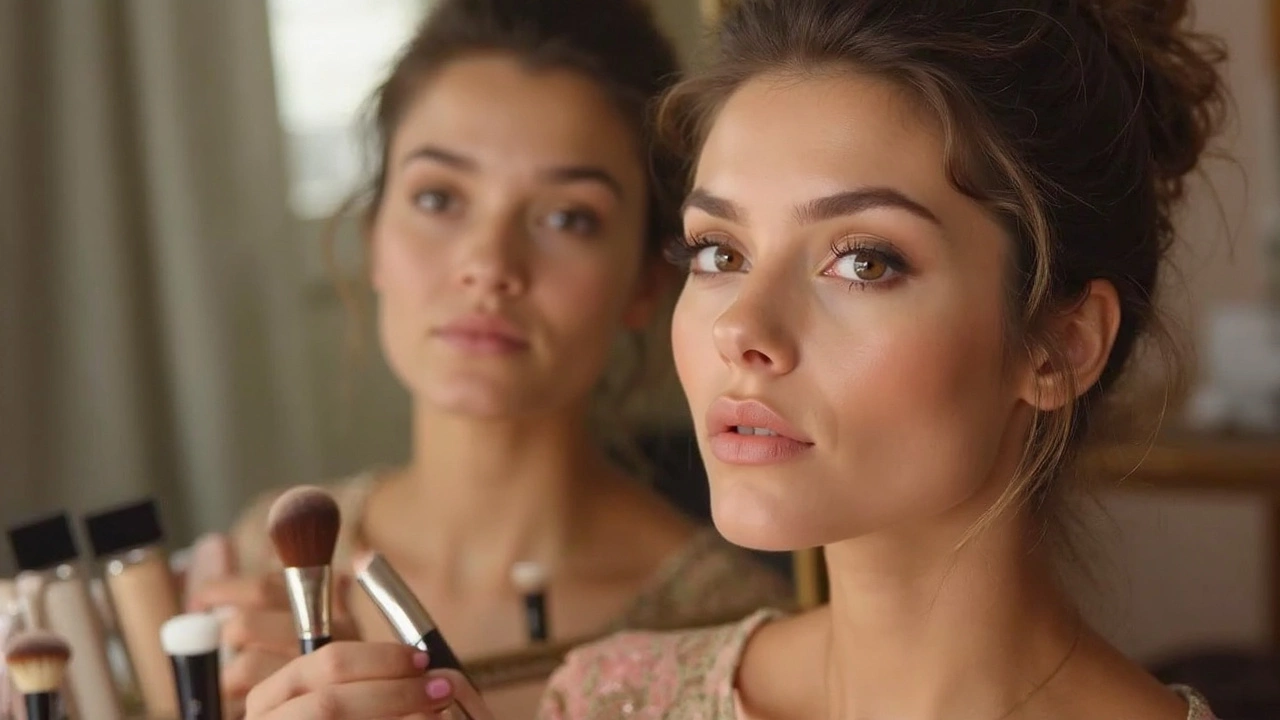Here's the lowdown on the great makeup debate: does concealer go on top of foundation or under it? If you've ever found yourself standing in front of a mirror, makeup brush in hand, pondering this very question, you're not alone. Let's break it down, shall we?
Typically, makeup artists suggest starting with foundation. Why? It evens out your skin tone and provides a base, reducing the amount of concealer you'll need. Think about your foundation as a canvas—it sets the stage for the rest of your products.
But wait, there's a twist! Some swear by applying concealer first, especially for targeting blemishes and under-eye circles. Doing this allows for more precise coverage and reduces the risk of wiping away concealer when blending your foundation later.
So which method is best? Honestly, it depends on your skin type and the look you're going for. Oily skin? You might favor the foundation-first technique to avoid a cakey finish. Need to cover up a stubborn spot? Try the concealer-first trick.
- Understanding Concealer and Foundation
- Applying Foundation First
- Starting with Concealer
- Skin Type Considerations
- Techniques for Flawless Blending
- Common Mistakes to Avoid
Understanding Concealer and Foundation
Before we dive deeper, let’s chat about what concealer and foundation actually do. Think of concealer as your secret weapon—it’s all about targeting specific imperfection like blemishes, under-eye circles, and redness. It’s generally thicker and more pigmented, which makes it perfect for that job.
Now onto foundation. Its main gig is to create an even base for the rest of your makeup. Foundations come in various forms—liquid, powder, cream, you name it! The goal is to even out your skin tone and provide a smooth canvas.
Choosing the Right Formula
Picking the right type of concealer and foundation is crucial. If you’ve got oily skin, you might find a matte foundation keeps the shine in check. Similarly, drier skin types usually prefer hydrating or dewy foundations. Concealers follow the same rule—liquid for a natural finish, while stick and cream formulas offer heavier coverage.
Ingredients to Look For
Both products have come a long way in terms of formulation. Nowadays, many contain nourishing ingredients like hyaluronic acid for hydration, and SPF for sun protection. Some even boast skincare benefits with antioxidants to protect your skin from environmental stressors.
Fun Fact
Did you know the first modern foundation was Max Factor’s Pan-Cake in the 1930s, originally developed for film actresses? Talk about a make-up marvel!
So, what's the takeaway? Whether you start with concealer or foundation, understanding their distinct roles helps you use them more effectively. A little knowledge about the products in your makeup bag can go a long way in achieving that flawless finish you’re after!
Applying Foundation First
So, you're leaning towards putting foundation on before concealer? Good choice! Many makeup pros and beauty enthusiasts recommend this method because it simplifies achieving an even base. When you apply your foundation first, it neutralizes the overall skin tone, minimizing the work your concealer has to do.
Step-by-Step Process
- Prep Your Skin: First things first, start with a good moisturizer. It hydrates your skin and helps the foundation blend smoothly. Don't skip primer if you're going for longevity—think of it as a little insurance.
- Apply Foundation: Use a brush, sponge, or even your fingers to apply. Focus on blending outwards and covering any major discolorations. Remember, less is more. You can always build up!
- Spot Conceal: Now grab your concealer. Focus on specific problem areas like dark circles or blemishes. Targeted application here lets you use a lighter hand while still achieving great coverage.
Why It Works
This technique has several advantages. It reduces the risk of using more product than necessary, which can make your makeup feel heavy or appear cakey. Since the foundation provides a base layer, it also means the concealer doesn’t get swept away during blending.
And if you're worried about makeup meltdown mid-day, fear not! Setting your makeup with a bit of translucent powder can lock everything in. According to a 2023 survey of beauty enthusiasts, about 65% reported that their makeup lasted longer when they applied foundation first, followed by targeted concealer application.
| Technique | Makeup Longevity Rating |
|---|---|
| Foundation First | 8.5/10 |
| Concealer First | 7.9/10 |
So, if you’re aiming for a fresh-faced look that lasts, considering the foundation-first method might just be your new go-to!
Starting with Concealer
Deciding to apply concealer before foundation can be a game-changer, especially when you're dealing with specific issues like dark circles or blemishes. Let’s dive into why some makeup pros advocate for this approach.
Pinpoint Precision
By using concealer first, you can target specific areas that need extra coverage. This method works wonders for focusing on trouble spots without overloading the rest of your face with product. So if you're dealing with a breakout or those infamous under-eye bags, starting with concealer allows for precise application.
A Natural Look
For those who prefer a natural, less-is-more approach, applying concealer first can help achieve that look. This technique can help you avoid layering on too much foundation, which is great if you’re aiming for a fresh-faced finish.
Choosing the Right Concealer
Opt for a creamy concealer that blends easily into the skin. Liquid concealers offer more flexibility, making them perfect for under the eyes, while stick formulas provide heavy coverage for blemishes.
Step-by-Step Guide
- Begin by prepping your skin with a moisturizer and primer to ensure a smooth base.
- Apply a small amount of concealer to the areas needing coverage. Remember, less is more.
- Gently blend the concealer with a brush or your fingers, using a tapping motion for a seamless finish.
- Follow up with your foundation, applying it over the concealer and blending carefully to avoid disturbing your hard work.
Pro Tip
If you're aiming to cover redness, consider a green-tinted concealer before your foundation. This can neutralize the color, reducing the amount of foundation needed to achieve even skin tone.
Remember, makeup is all about experimentation to find what works best for you. Test out both methods and see which suits your skincare routine and personal style best!

Skin Type Considerations
Let's face it: skin type plays a huge role in determining whether to apply concealer before or after foundation. Knowing your skin type can be your secret weapon in nailing that flawless look.
Oily Skin
If your skin tends toward the oilier side, you'll probably find that applying foundation first works best. This method can help control the shine by providing a matte base. Plus, since oily skin often has larger pores, using foundation first can help smooth the texture before you add concealer for those specific blemishes.
Dry Skin
Dry skin beauties, listen up! You might want to avoid applying too much of both products to prevent flakiness. A pro tip? Hydrate with a good moisturizer first. A creamy concealer, applied before foundation, can help hide dry patches and even out skin tone.
Combination Skin
Having combo skin means you need to tackle both dry and oily areas differently. You might consider using a foundation for overall balance and follow up with concealer specifically in areas that need extra love, whether it’s the dry spots or the T-zone.
Sensitive Skin
Sensitive skin folks, alignment is key. Investing in hypoallergenic or fragrance-free products could save you from irritation. Try applying a thin layer of foundation first to reduce the number of products directly touching your skin, then dab on concealer where necessary.
Remember, there's no hard and fast rule, so it might just come down to a bit of trial and error to see what makes your skin happiest. Whether you're team concealer or team foundation, finding the method that works best for your unique skin type is the goal!
Techniques for Flawless Blending
Nailing the blending game is crucial for that seamless makeup finish we all crave. It feels amazing when your makeup looks airbrushed and natural. So, what are the secrets?
Tools of the Trade
Your fingers might do in a pinch, but investing in the right tools can make all the difference. A damp beauty sponge or a high-quality brush can be your best friend when blending foundation and concealer. Why a damp sponge? It helps with even distribution and prevents wastage of product.
Layer It Right
The order in which you apply things is key. After moisturizing and priming your skin, start with foundation to even out the canvas. Use your tools in a dabbing motion rather than dragging. Follow up with concealer on areas needing extra coverage. Blending is all about layers, not chunks, so take your time!
Techniques to Try
- Bouncing – Tap your sponge lightly on your face, this technique helps blend the product without wiping it away.
- Buffing – Use small circular motions with a brush to blend for a natural finish.
- Stippling – Ideal for creating a softer look, stipple with a brush with light hand movements.
Common Errors
Avoid pressing too hard with your tools. Not only can it remove product, but it can also streak your makeup. It's about almost painting on the layers gently.
Advanced Tips
If you're looking to get fancy, try color-correcting concealers before the foundation step to tackle distinct skin issues. Light peach works wonders on dark under-eye circles for those with lighter skin tones, while deeper peach or orange suits deeper complexions.
And, keep in mind, natural light is your best friend for blending. Your indoor lighting might deceive you, so check your work near a window before stepping out the door.
Believe in your practice. Keep experimenting with different tools and techniques until you find your perfect blending match. Remember, it's as much about the journey as the destination.
Common Mistakes to Avoid
Navigating the world of makeup can sometimes feel like a maze. But hey, no worries! We've all made a few blunders along the way. Let’s spotlight some common mistakes to steer clear of when it comes to using concealer and foundation.
1. Wrong Shade Matching
One biggie is picking the wrong shade for either your concealer or foundation. A common pitfall is going too light with concealer under the eyes thinking it’ll brighten up dark circles. Instead, aim for a shade just a touch lighter than your foundation for a natural look.
2. Applying Too Much Product
Another frequent mishap is layering on too much product. Trust me, the caked-on look is never in. Opt for a buildable approach—start with a light layer and add more if necessary. Your skin should still look like skin, not a mask.
3. Ignoring Your Skin Type
Not considering your skin type is another mistake. For instance, using a creamy concealer on oily skin might lead to unwanted shine. Or, choosing a matte foundation for dry skin can highlight flakiness. Choose products that align with your skin needs.
4. Forgetting to Blend
Blending is key, folks. Whether you’re using a beauty sponge, brush, or your fingers, make sure everything’s seamless. Harsh lines around the edges of your foundation or makeup can be a dead giveaway.
5. Skipping Primer
Lastly, skipping primer can mess with how your makeup sits and stays throughout the day. A primer suited for your skin type helps everything else you apply last longer and look flawless.
Paying attention to these little details can level-up your beauty game big time. Remember, makeup is all about trial and error—don’t stress the mess-ups; it’s how we learn and get better!


